An atrium, an architectural feature in houses, varies in size, functionality, uses, furniture, and renovation. Its length ranges from 45 square feet (4 square meters) to 90 square feet (8 square meters) for small spaces, 90 square feet (8 square meters) to 130 square feet (12 square meters) for average atriums, and exceeds 215 square feet (20 square meters) in grand luxury estates. The atrium’s primary functions include enhancing natural lighting, improving ventilation, providing communal space, and adding aesthetic appeal. These spaces often serve as home focal points, featuring skylights or large openings for sunlight. They also facilitate air circulation, contributing to a healthier living environment. Atriums have rectangular or square shapes for spatial efficiency and openness. They accommodate various furniture types, including seating, coffee tables, planters, side tables, display cabinets, and sun loungers. Atriums are usually painted in white, light gray, beige, soft blue, earthy green, warm yellow, or terracotta, each contributing to the space’s ambiance. Energy efficiency in atriums is achieved through energy-efficient glazing, passive solar design, adequate insulation, intelligent climate control systems, energy-efficient lighting, and solar panels. Hiring an architect for such renovations is often essential, especially for substantial changes. Architects help redesign layouts, improve natural light, incorporate green features, upgrade materials, improve acoustics, incorporate custom features, and upgrade lighting. Redecorating an atrium takes 2 to 5 weeks, depending on the extent of changes. Homeowners face challenges like water damage, concrete aesthetics, flooding, lack of plants, insufficient lighting, acoustic issues, and adding custom features during renovation.
What is the typical size of an atrium?
A typical residential atrium ranges between 45 square feet (4 square meters) and 90 square feet (8 square meters). This allows for a modest seating area overlooking a small garden or water feature below. Standard home ceiling height of 8 feet (2.4 meters) or up to 10 feet (3 meters) works well. The footprint provides intimate space for 1-2 people to pause and enjoy natural light and air circulating through the home. The average atrium size measures between 90 square feet (8 square meters) and 130 square feet (12 square meters), better accommodating furnishings. Ceiling heights range from 10 feet (3 meters) to 15 feet (4.5 meters), and average atriums incorporate narrow water features or plant beds lining the base of walls. A slim bench, table, and chairs nearby allow 3 to 4 people to relax in the light-filled transitional space. Grand atriums in luxury estates open to internal expenses exceeding 215 square feet (20 square meters) minimally, frequently spanning 430+ square feet (40+ square meters). Custom skylights and glass ceiling systems allow light to wash through the towering room. Spacious layouts incorporate substantial water elements, fire features, multiple seating areas, and specialty 56 landscaping horizontally and vertically.
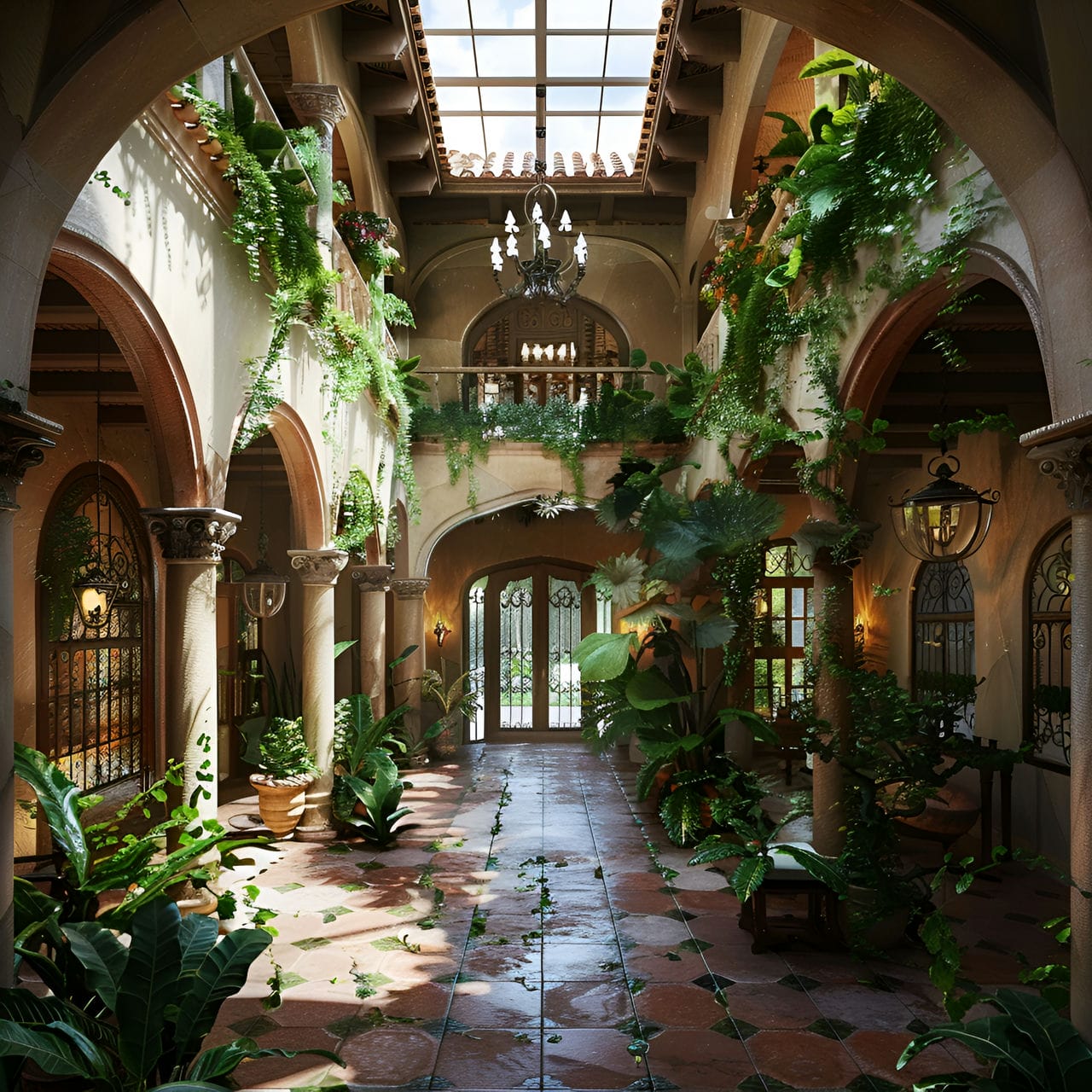
What is the use and purpose of an atrium?
The purpose of an atrium is to enhance natural lighting, improve ventilation, provide a communal space, add to the aesthetic appeal, offer opportunities for indoor gardening, and increase property value. Firstly, it acts as a significant source of natural light. Its design features large openings or a skylight, allowing sunlight to penetrate the house, illuminating interior spaces and reducing reliance on artificial lighting. Secondly, the atrium plays a crucial role in ventilation. Its architecture is often conducive to air circulation, aiding in cooling the house and improving air quality, which is vital for a healthy living environment. Thirdly, an atrium serves as a communal space, fostering social interactions. Traditionally positioned as the heart of a home, it provides a gathering area for family and guests, enhancing collaborative living experiences. Fourthly, the aesthetic appeal of an atrium must be considered. Its grand and open design adds a unique architectural element to a house, making it visually appealing and often serving as a focal point. Lastly, atriums can increase the property value of a home. A well-designed atrium is often desirable in real estate, making such homes more attractive to potential buyers and possibly raising their market value. This aspect makes atriums an architectural feature and an investment in the property.
What is the typical shape of an atrium?
The typical shapes of an atrium are rectangular or squared footprints for spatial efficiency while still feeling open. The most common atrium layout uses a rectangular or squared footprint for spatial efficiency. Average rectangular plans situate the longest walls spanning 13 feet (4 meters) to 26 feet (8 meters) facing each other with narrow ends ranging from 8 feet (2.5 meters) to 13 feet (4 meters) on opposite sides. Centered openings or entryways connect the transitional room throughout interior living spaces. Square atriums range from 40 square feet (4 square meters) to 125 square feet (12 square meters) equally in all orientations.
What furniture commonly equips an atrium?
Listed below are the types of furniture commonly equip an atrium:
- Seating Furniture: Seating furniture like sofas, armchairs, or benches provides a comfortable place in an atrium. This furniture can be chosen to match the architectural style of the atrium and can be arranged to encourage conversation or provide quiet relaxation spots.
- Coffee Tables: Coffee tables are functional and decorative furniture in an atrium. They provide a surface for placing drinks, books, or decorative items. The style and material of the coffee table can be chosen to complement the other furniture and the design of the atrium.
- Planters: Planters are a standard piece of furniture in atriums. They can house various plants, adding greenery and life to the atrium. Planters come in multiple sizes, shapes, and materials, allowing for different planting options.
- Side Tables: Side tables provide additional surface space in an atrium, useful for holding drinks, books, or decorative items. They can be placed next to seating furniture for convenience. Like coffee tables, side tables can be chosen to match the style and material of the other furniture in the atrium.
- Display Cabinets: Display cabinets can be used in an atrium to showcase collectibles, art pieces, or other decorative items. This furniture can add a personal touch and create a focal point. Display cabinets can be freestanding or wall-mounted, depending on the available space and the atrium design.
- Outdoor Dining Sets: The atrium is designed to function as an outdoor living space, and an outdoor dining set can be a practical addition. This furniture can include a table and chairs made from materials that can withstand outdoor conditions.
- Sun Loungers: Sun loungers can be a comfortable addition to atriums with ample sunlight. This furniture can provide a place to relax and enjoy the warmth and light. Sun loungers are durable, weather-resistant materials and can be paired with cushions for added comfort.
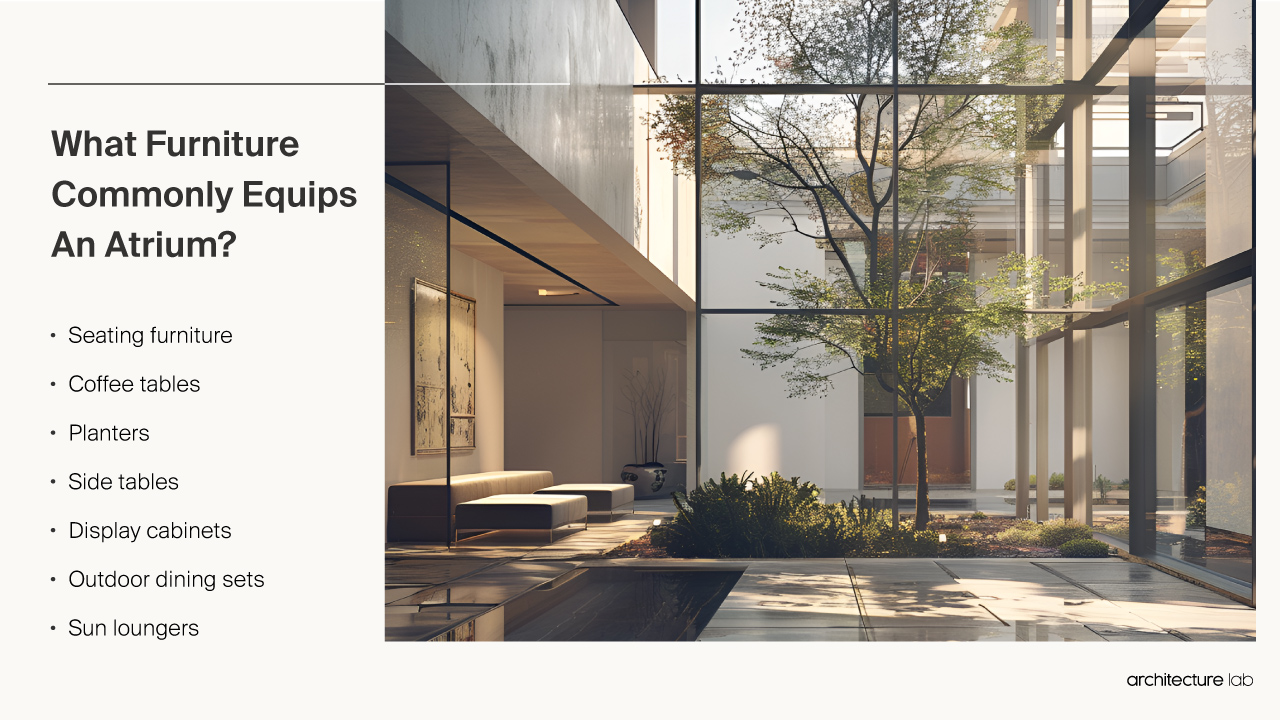
What is the normal ceiling height of an atrium?
The normal ceiling height of an atrium ranges from 35 square feet (3 square meters) to 48 square feet (4.5 square meters). Standard heights allow clearance for lighting fixtures centered under skylights without infringing on usable space below. Contemporary atriums may incorporate ceilings starting at 38 square feet (3.5 square meters) to 65 square feet (6 square meters), which provides a generous sense of verticality complementing the openness. Smaller footprint atriums under 90 square feet (8 square meters) feel cramped, with ceiling heights exceeding 48 square feet (4.5 square meters). Luxury estate atriums elevate architectural details with ceiling heights of up to 86 square feet (8 square meters).
What colors are atriums usually painted?
Listed below are the colors usually used in atriums:
- White: Atriums frequently use white to create a sense of spaciousness and light. This color reflects natural light beautifully, making the atrium larger and more open. White is a versatile backdrop for plants and artwork, allowing other elements in the space to stand out.
- Light Gray: Light gray in atriums offers a contemporary and sophisticated look. This color contrasts with white, adding depth without overwhelming the space. Spare gray pairs well with modern decor and greenery, enhancing the natural elements often found in atriums.
- Beige: Beige in atriums brings a warm and inviting feel. This neutral color complements natural light and works well with various textures and materials. Beige offers a soothing backdrop that pairs easily with bright and muted decor elements.
- Soft Blue: Soft blue in atriums creates a serene and airy atmosphere. This color mirrors the sky, enhancing the open feel of the space. Soft blue is calming and pairs well with natural wood and stone, often used in atriums.
- Earthy Green: Earthy green tones in atriums complement the natural greenery found in these spaces. This color creates a cohesive indoor-outdoor feel, making the space feel more connected to nature.
- Warm Yellow: Warm yellow in atriums adds brightness and energy. This color is effective in north-facing or dimly lit atriums, as it can simulate sunlight and create a more inviting ambiance. Warm yellow works well with modern and traditional decor, bringing a cheerful touch to the space.
- Terracotta: Terracotta in atriums introduces a rustic and warm feel. This earthy color is reminiscent of natural clay and pairs with green plants and wooden accents. Terracotta adds a Mediterranean or Southwestern flair to the space, making it feel cozy and inviting.
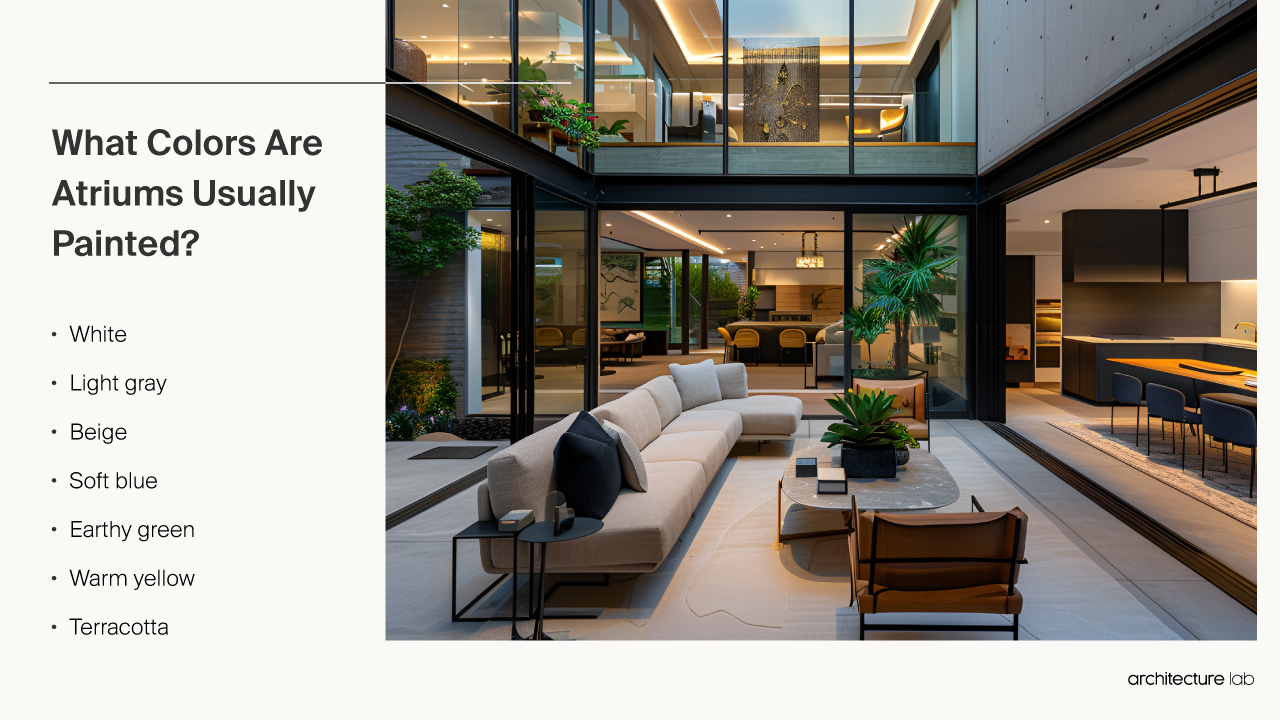
What makes the atrium functional?
The atrium is functional by improving indoor air quality and ventilation, providing informal meeting space, providing natural light, and accommodating needs. Firstly, an atrium improves indoor air quality and ventilation. The vertical structure of an atrium encourages air movement, drawing in cool air at the bottom and releasing warm air at the top. Secondly, an atrium can serve as an informal meeting space where intellectual and social exchange can occur. This makes it a key architectural feature in a building’s main entries, public circulation areas, or special destinations. Thirdly, the atrium’s design often involves skylights and glazing areas that infuse natural light, giving the building a feeling of space and light. Lastly, the atrium requires flexibility, durable finishes, attention to regular maintenance, and unique HVAC systems and lighting.
How is energy efficiency achieved in an atrium?
Energy efficiency is achieved in an atrium through passive solar design, insulation, climate control systems, energy-efficient lighting, and including indoor plants and water features. Firstly, incorporating passive solar design principles is critical. Orienting the atrium to maximize natural light and heat from the sun during colder months while minimizing exposure during hot periods can significantly reduce greenhouse consumption. Secondly, implementing effective insulation is essential. Well-insulated walls and roofs help maintain the atrium’s temperature, decreasing artificial heating and cooling needs. High-quality insulation materials and techniques ensure that the atrium remains energy-efficient throughout the year. Thirdly, integrating intelligent climate control systems contributes significantly. These systems can adjust the indoor temperature based on external weather conditions, occupancy, and time of day. Smart thermostats and sensors can optimize energy usage for heating and cooling, making the atrium more energy-efficient. Fourthly, using energy-efficient lighting is essential. LED lights and intelligent lighting systems that adjust based on natural light availability can reduce electricity usage. Fifthly, incorporating energy-generating elements like solar panels can transform the atrium into a net energy producer. Solar panels can harness solar energy to power lighting and other electrical needs in the atrium. Lastly, including indoor plants and water features can aid in regulating the atrium’s microclimate. Plants can improve air quality and help maintain humidity levels, reducing the need for air purifiers and humidifiers.
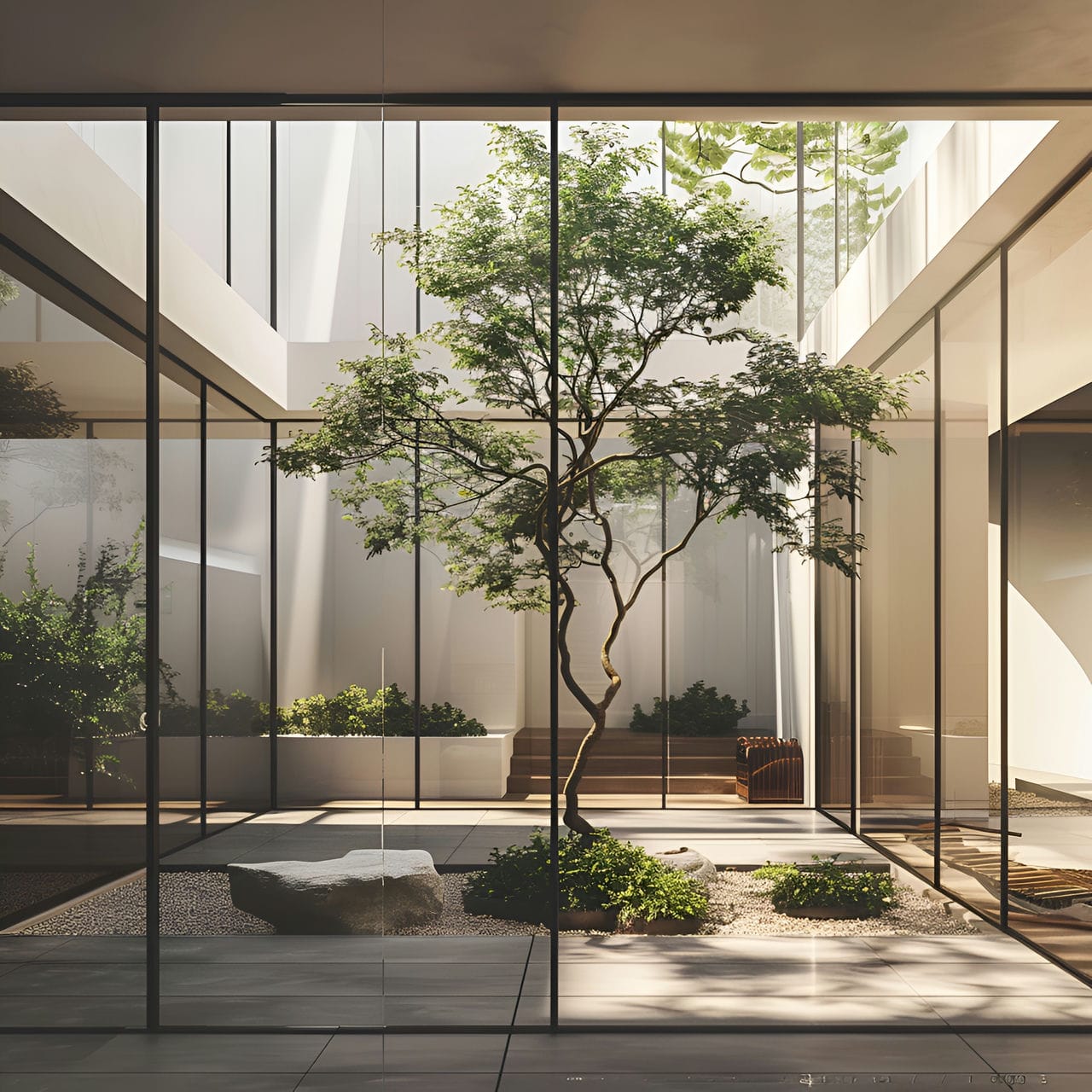
How much does it typically cost to renovate an atrium?
The average cost to renovate an existing small 14-foot by 14-foot (4 meters by 4 meters) to medium 26-foot by 26-foot (8 meters by 8 meters) residential atrium is between $15,000 (€13,500, £11,400) to $40,000 (€36,000, £30,300). Cosmetic changes like repainting, new lighting fixtures, or floor coverings cost $15,000 (€13,500, £11,400). Structural changes like moving interior walls, altering roof structures or skylights, replanting gardens, or adding water features or specialty railings drive prices higher. Fire safety updates can reach $10,000 (€9,000, £7,600) alone. High-end, architect-designed renovations of spacious 39-foot by 39+-foot (12-meter by 12+-meter) atriums incorporating glass ceilings, indoor/outdoor living space integration, custom masonry, mechanical ventilation systems or climate control, water features, and integrated building technology synchronize with the architecture and span $150,000 (€135,000, £114,000) or more. Standard atrium improvement budgets range from $15,000 (€13,500, £11,400) to $40,000 (€36,000, £30,000) depending on the scale and design ambition, while fully custom grand atriums match the price with a luxury vision from $100,000+ (€90,000+, £75,200+).
What factors affect the atrium renovation?
Listed below are the factors that affect the atrium renovation:
- Lighting: Proper lighting is crucial for an atrium renovation. The type, placement, and lighting intensity can dramatically impact the aesthetics and functionality of the space. Careful planning is needed to ensure adequate natural light through skylights or windows, supplemented by artificial lighting for evenings and cloudy days.
- Acoustics: An atrium can be a challenging acoustic environment due to hard surfaces and high ceilings. Managing noise control and echo should be a priority in an atrium renovation. Sound-absorbing materials on walls and ceilings and sound barriers can help reduce reverberation.
- Greenery: Incorporating plants and greenery into an atrium renovation can provide visual interest and a connection to nature. Consider large statement trees and plants, vertical gardens on walls, and hanging gardens from the ceiling.
- Weatherproofing: Atriums can be challenging to maintain internal comfort due to influences from external weather. Strategies like thermally efficient glass, heating systems, ceiling fans, and shading solutions help moderate temperature. Consider rain sensors, drainage systems, and waterproof materials to manage moisture issues.
- Furnishings: Comfortable, durable, and visually appealing furnishings will maximize usage and enjoyment of the renovated atrium. Select pieces that fit the desired aesthetic while accommodating groups in flexible seating arrangements.
- Security: Safety and security should be addressed in an atrium renovation, especially if it is publicly accessible. Consider video monitoring, access control systems, and security patrols. Design elements like visibility, lighting, and landscaping can also enhance the natural surveillance of the space.
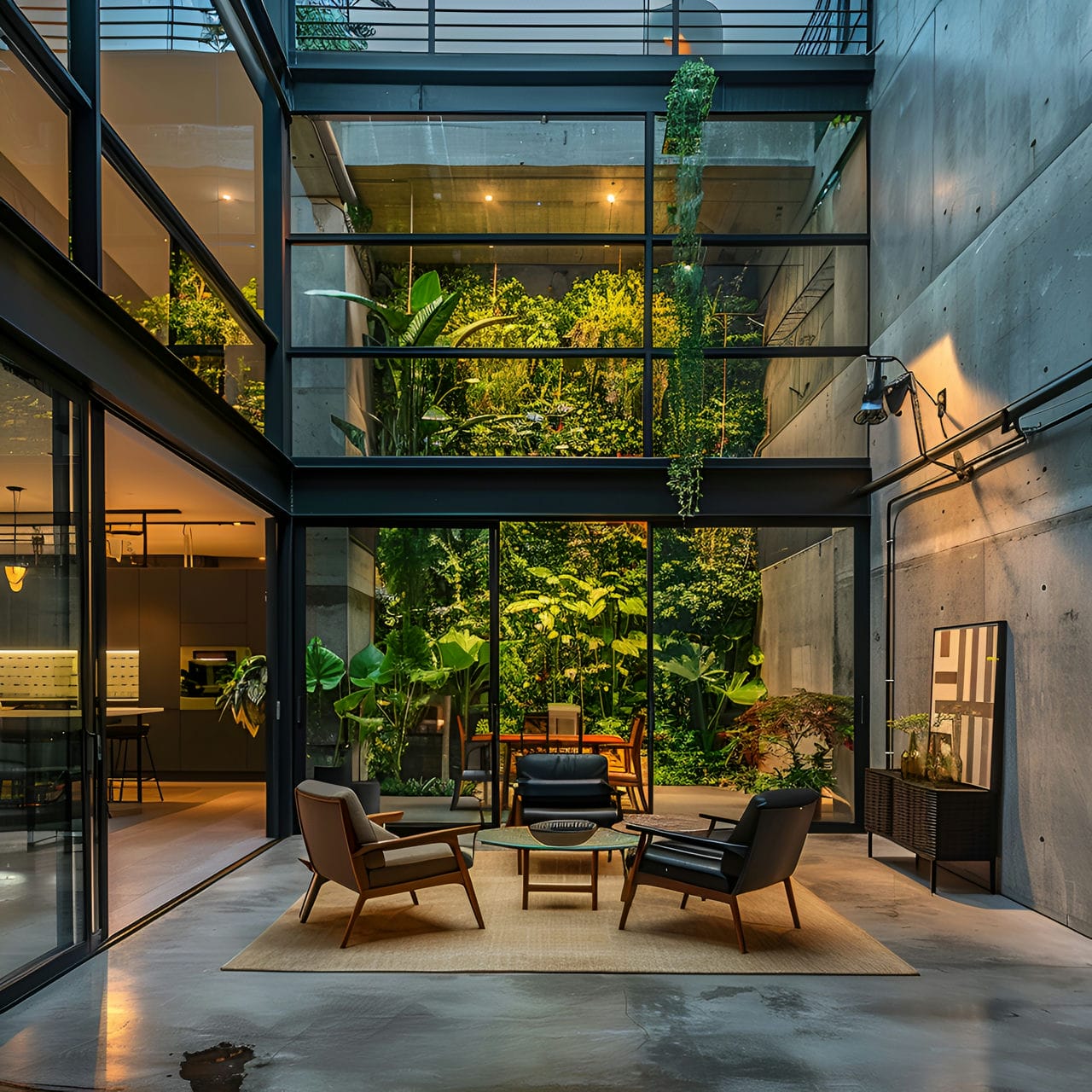
Is an architect required to renovate an atrium?
No, hiring an architect to renovate an atrium is not required but highly advise hiring one. Architects have the skills to effectively plan and optimize the space, ensuring that the renovated atrium looks pleasing and functions well in light distribution, ventilation, and spatial flow. An architect’s knowledge is invaluable for renovations involving structural modifications, such as altering the roofline, adding skylights, or reconfiguring the layout. They ensure that the design is both safe and compliant with building codes. Their ability to envision and execute complex designs can transform an atrium into a focal point of a building.
How can an architect help you upgrade an atrium?
Listed below are the ways that an architect can help an owner upgrade an atrium:
- Redesign the layout: An architect can help reconfigure the atrium space to use the area better. This could involve opening up walls, relocating stairs or hallways, or making other structural changes to create a more open, functional layout. The new design should improve sight lines, accessibility, flow between rooms, and opportunities for furnishings or features like water features.
- Improve natural light: Architects can identify ways to increase natural light in an atrium. This may include adding more windows and skylights or using light shelves, tubes, or reflective materials.
- Incorporate green features: Architects can integrate nature into an atrium design, from living walls and plants to water features and green roofs. The green elements can be designed to be low-maintenance as well.
- Upgrade materials: An architect can replace outdated or worn materials in an atrium with more modern, durable options. This includes floors, walls, railings, steps, ceilings and trim.
- Improve acoustics: The openness of atriums can sometimes cause noise issues. An architect can address acoustics through sound-dampening materials on surfaces, white noise systems, and physical design changes.
- Upgrade lighting: Proper lighting can significantly impact the aesthetics and function of an atrium. Architects can install skylights, accent lighting, adjustable fixtures, and intelligent technology to create ambient and task lighting.
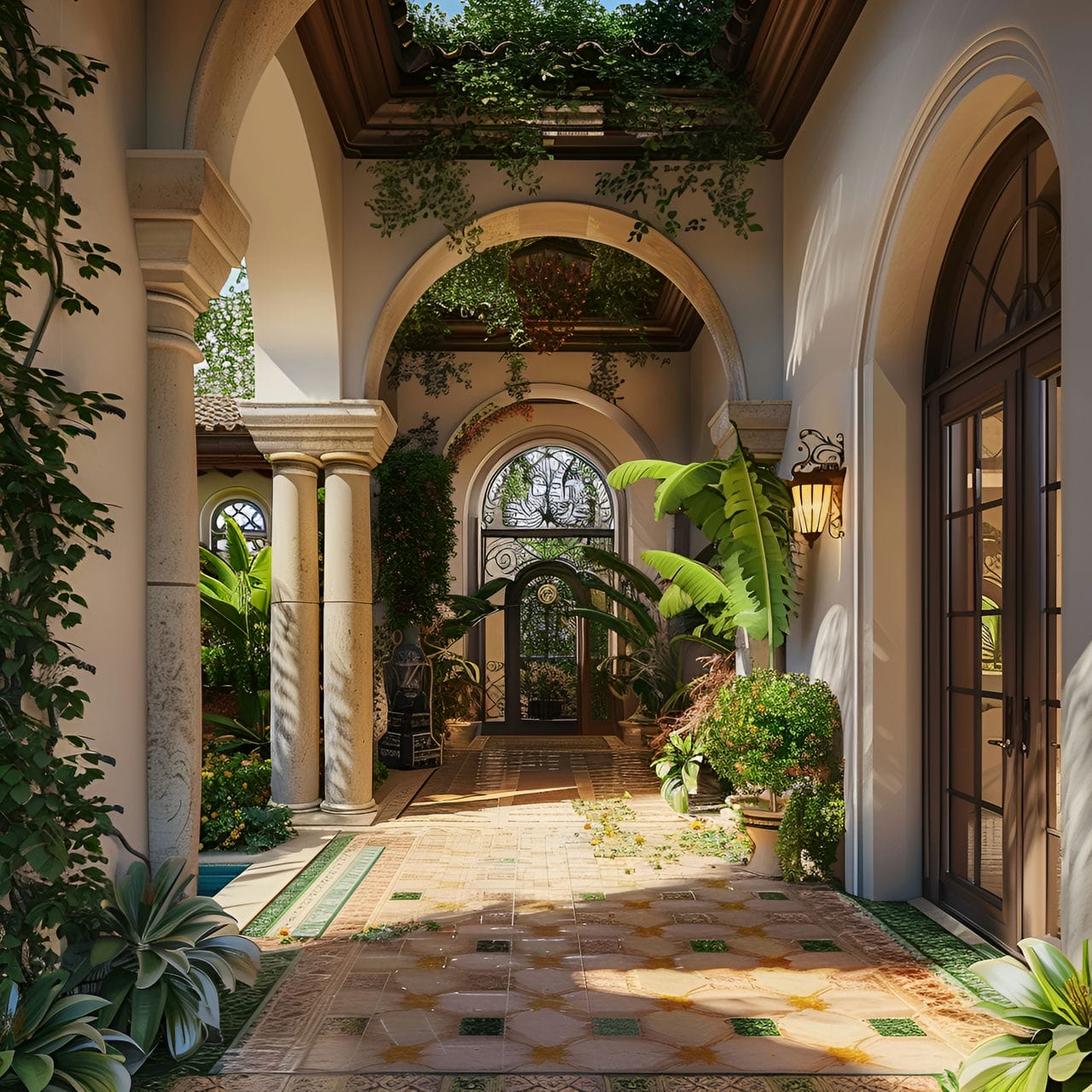
How much does it cost to hire an architect to renovate an atrium?
The average cost to hire an architect to design an atrium renovation ranges from $3,000 (€2,700, £2,300) to $20,000+ (€18,000+, £15,200+) based on the scale and custom details involved. Most residential architects charge $100 (€90, £75) to $200 (€180, £150) per hour. Refreshing an existing small 14-foot by 14-foot (4-meter by 4-meter) atrium space with simple lighting updates or flooring replacements may take only 10-15 hours for fees ranging from $2,000 (€1,800, £1,500) to $3,000 (€2,700, £2,300). Renovating an average 26-foot by 26-foot (8-meter by 8-meter) atrium incorporating skylight redesigns, layout changes like removing walls, adding new entryways, or structural builds for water features, gardens, or seating could require 30-50 hours of architectural time averaging $5,000 (€4,500, £3,800) to $10,000 (€9,000, £7,600). Top-tier designers revamping grand estate atriums spanning 39-foot or more lengths/widths to incorporate retractable glass ceilings, two-story vertical gardens, stonework, and integrated automation controlling lighting/music run $20,000+ (€18,000+, £15,200+) and their elaborate experiential concept spaces necessitate 80-100+ hours working through structural engineering constraints. Simple atrium touch-ups run just $3,000 (€2,700, £2,300), while customized renovations average $5,000 (€4,500, £3,800) to $20,000+ (€18,000+, £15,200+).
Is it worth it to hire an architect to upgrade an atrium?
Yes, it is worth hiring an architect to upgrade an atrium. An architect’s expertise is beneficial for enhancing such a unique and central space. Atriums require thoughtful design considerations to maximize natural light, ensure efficient use of space, and improve aesthetic appeal. Architects can provide innovative solutions to these challenges, leveraging their materials, structural dynamics, and spatial design knowledge. They can skillfully integrate new elements, like skylights or greenery while respecting the existing architecture.
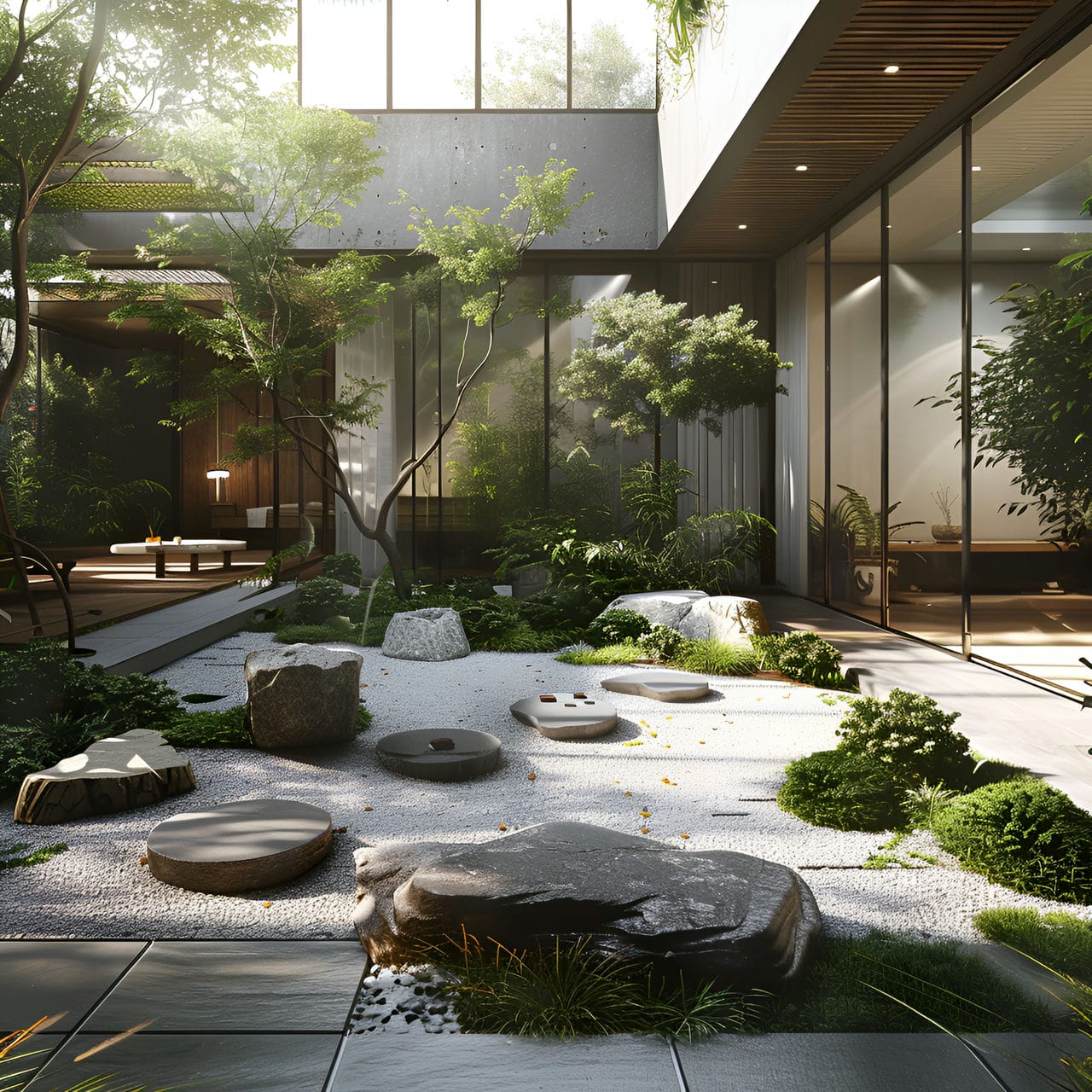
How long is needed to redecorate an atrium?
To redecorate the atrium, a timeframe of 2 to 5 weeks is needed. Firstly, simple aesthetic changes like repainting, adding new planters, or updating light fixtures can be completed within 1 to 2 weeks. Secondly, more extensive modifications like installing new flooring, adding water features, or significant landscaping work can extend the timeline to 3 to 4 weeks. These projects are more complex and may involve coordination with multiple professionals or suppliers. Thirdly, if the redecoration includes structural alterations, such as changing the layout, adding skylights, or modifying architectural elements, the project could take up to 5 weeks or more. These renovations require careful planning, skilled labor, and permits and approvals. Fourthly, the availability of materials and contractors can affect the timeline. Delays in obtaining the necessary materials or scheduling professional services can extend the project duration. Lastly, potential challenges, like weather conditions for outdoor atriums or logistical issues in accessing the area, especially in multi-story buildings, can further prolong the redecoration process.
What are the struggles of the homeowner to redecorate an atrium?
Listed below are the struggles of the homeowner to redecorate an atrium:
- Water damage: The water damage in an atrium destroyed wood floors and caused mold growth. This was costly to repair before even thinking about decorating. The water was entering from the atrium flowerbeds and seeping beneath the foundation.
- Concrete aesthetics: Concreting the entire atrium, while necessary for waterproofing, resulted in a loss of visual appeal. The homeowner needed help with ways to improve the look of the plain concrete to regain some of the previous aesthetics.
- Living room flooding: Water continued leaking into the connected living room despite waterproofing efforts. This unresolved flooding hindered decorating attempts as it first needed to be correctly diagnosed and addressed before installing furnishings.
- Lack of plants: The atrium needed more greenery with the eliminated previous flowerbeds. The homeowner required help finding alternative ways to incorporate plants to soften the hardscape and add visual interest.
- Insufficient lighting: The enclosed atrium likely had inadequate natural and artificial lighting. The homeowner needed help finding well-placed light sources to make the space bright and welcoming.


